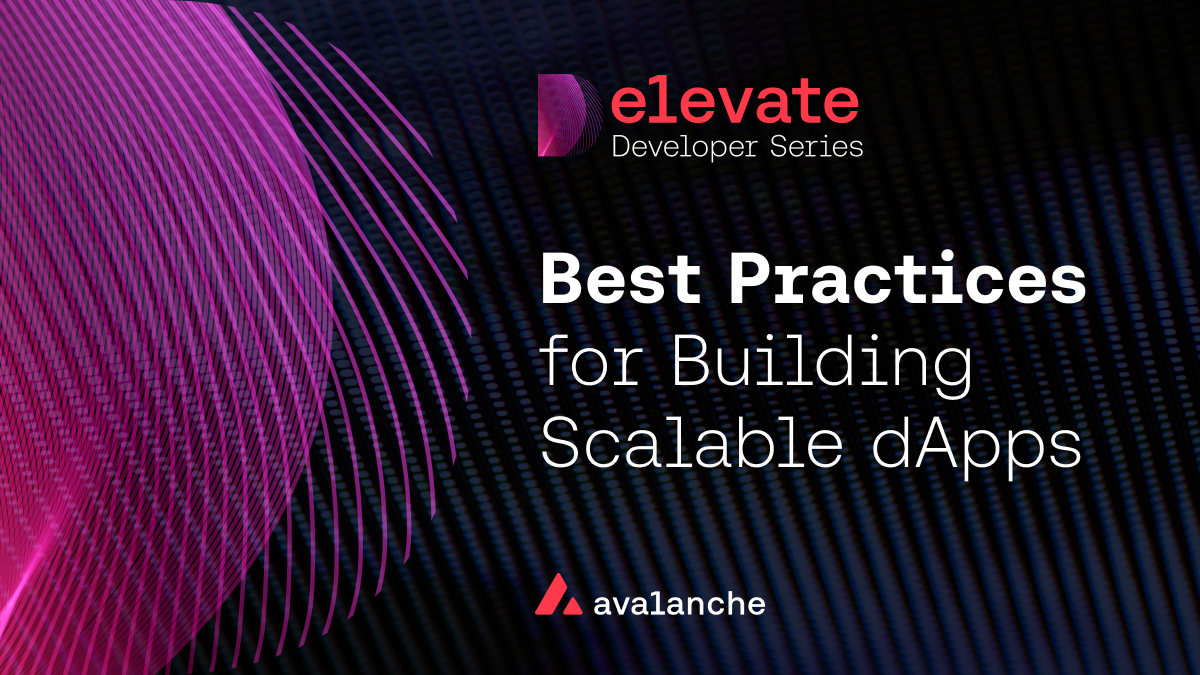Building Scalable dApps: Best Practices for Blockchain Developers

Imagine building a software project that got rave reviews, broke out of your social circle, and caught national or global attention. Sounds great, right?
But if your project wasn’t designed to scale, that kind of popularity might make the app unusable. Congestion, high gas fees and downtime can plague decentralized apps (dApps) unless builders follow scalability best practices.
Avalanche is dedicated to helping developers build and scale their creations. We’ll talk about how the Avalanche platform supports scalability further down the road. First, let’s look at best practices to keep in mind while you’re building.
Best Practices for Building Scalable dApps
Scalability isn’t something you tack on at the end of a build. It should be a major consideration throughout the development process, including these best practices:
Choose the right architecture
First, decide how your dApp will interact with the blockchain. There are two dominant approaches on blockchain design, a single-chain or multi-chain focus.
The first is integrated architecture, in which all smart contracts live on the same L1 blockchain. This gives the app a centralized liquidity hub and a host of other benefits, but also limits scalability, customization options, and gas spikes can occur under heavy usage as transactions compete to be included in the next block.
Layered architecture, on the other hand, uses multiple chains to offload various transactions, data storage, or other functions. This type of architecture has benefits in scaling, but can be complex to implement and has less native interoperability, that is to say its ability to connect to all other apps on the same blockchain.
At the platform level, Avalanche has introduced a unique layered architecture that optimizes for scaling to many interconnected chains. We call these Avalanche L1s, or Layer 1 chains that are sovereign, have their own validators, and other customizations. Making this all connected, Avalanche Interchain Messaging allows for messages and value to be passed among any Avalanche L1. This can be accessing data oracles, transferring tokens between chains, and accessing identity and balance info for users on each chain.
Optimize efficiency on your smart contracts
The design of your smart contracts can have a dramatic effect on scalability. Follow these best practices:
- Use batch processing—processing multiple transactions in a single contract call—to reduce overhead.
- Store only the absolute necessary data on-chain, and supplement with off-chain solutions for bulk and rarely-accessed data.
- Optimize your gas use: reduce unnecessary computations, avoid loop iterations, and minimize external contract calls.
- Keep your dApp upgradable by using proxy contracts that can upgrade your logic without redeploying.
Avoid bottlenecks in your dApp architecture
It’s important to make sure your backend supports scalability. An improperly designed backend can create limitations that will weigh down the entire app. Consider these elements:
- Use decentralized indexing solutions like The Graph, or custom indexing nodes, instead of on-chain queries.
- Load balances your queries over multiple endpoints instead of overloading a single node with API calls.
- Employ event-driven execution to trigger actions, instead of querying the chain for updates.
Design with interoperability in mind
Scalability requires seamless communications between chains. Without that element, there are hard limits on what your dApp can do without getting bogged down. Use cross-chain messaging protocols to interact with different blockchains.
You may need to work with third-party solutions when developing on other platforms. Avalanche features native interoperability through Avalanche Interchain Messaging (more on that later).
How Avalanche Supports Scalability
While these best practices are a foundational part of building scalable dApps, they can only take you so far. Our latest upgrade, Avalanche9000, is designed for virtually infinite scalability:
The C-chain is the Hub for Liquidity
The primary chain of Avalanche (the C-chain) acts as the liquidity hub and remains the economic foundation of Avalanche. Developers launching new L1s can tap into the c-chain’s liquidity from a robust ecosystem of apps, tooling and more.
Customizable L1s help the platform fit the project
Developers on Avalanche can fully customize their L1s. This includes staking, gas models, and custom validator sets that don’t require validation from the primary network. Developers can also implement various geo-restrictions to adhere to regulatory requirements.
Avalanche Interchain Messaging provides seamless interoperability
Unlike many other Layer 2 solutions, Avalanche L1s are natively interoperable out-of-the-box. Avalanche Interchain Messaging allows for instant messaging between chains, allowing assets and data to flow effortlessly across the network.
Community-driven development gives developers what they need
Avalanche as a platform is community driven. This latest upgrade shows how community proposals go from developer requests to fully realized features.
The core of Avalanche9000, the Etna upgrade, incorporates seven different community proposals. We knew that developers needed more cost-effective and customizable L1s, for example—because they told us.
This development process means that whatever developers might require in the future, Avalanche will be listening and ready to make it happen.
Multi-Chain is the Future of Scalable dApps
The blockchain community has spent years trying to scale single L1s. Avalanche has found that the solution is more L1s working together, expanding the scalability of the platform with every L1 added.
Check out the Avalanche9000 Comprehensive Guide to get started today.